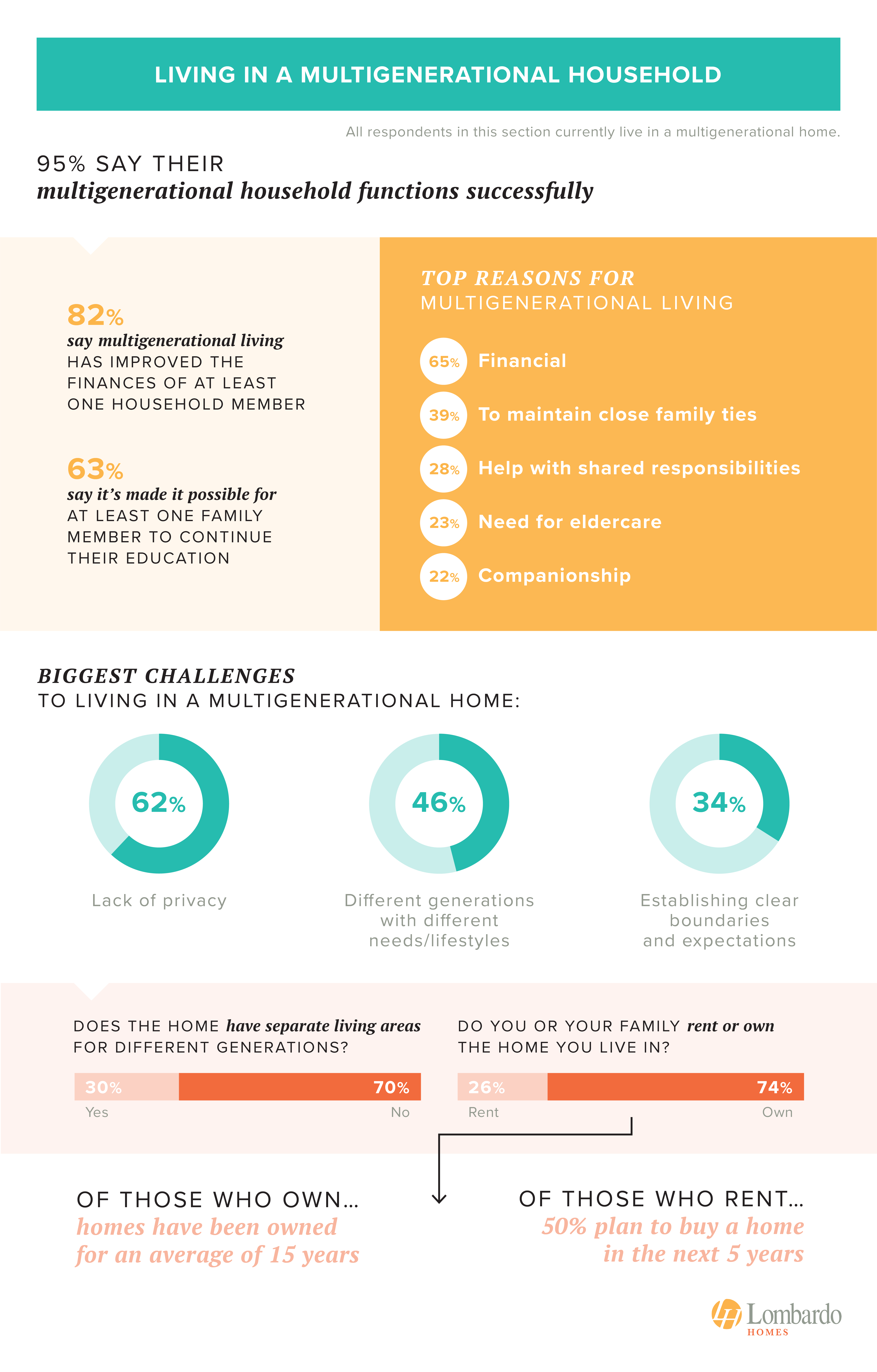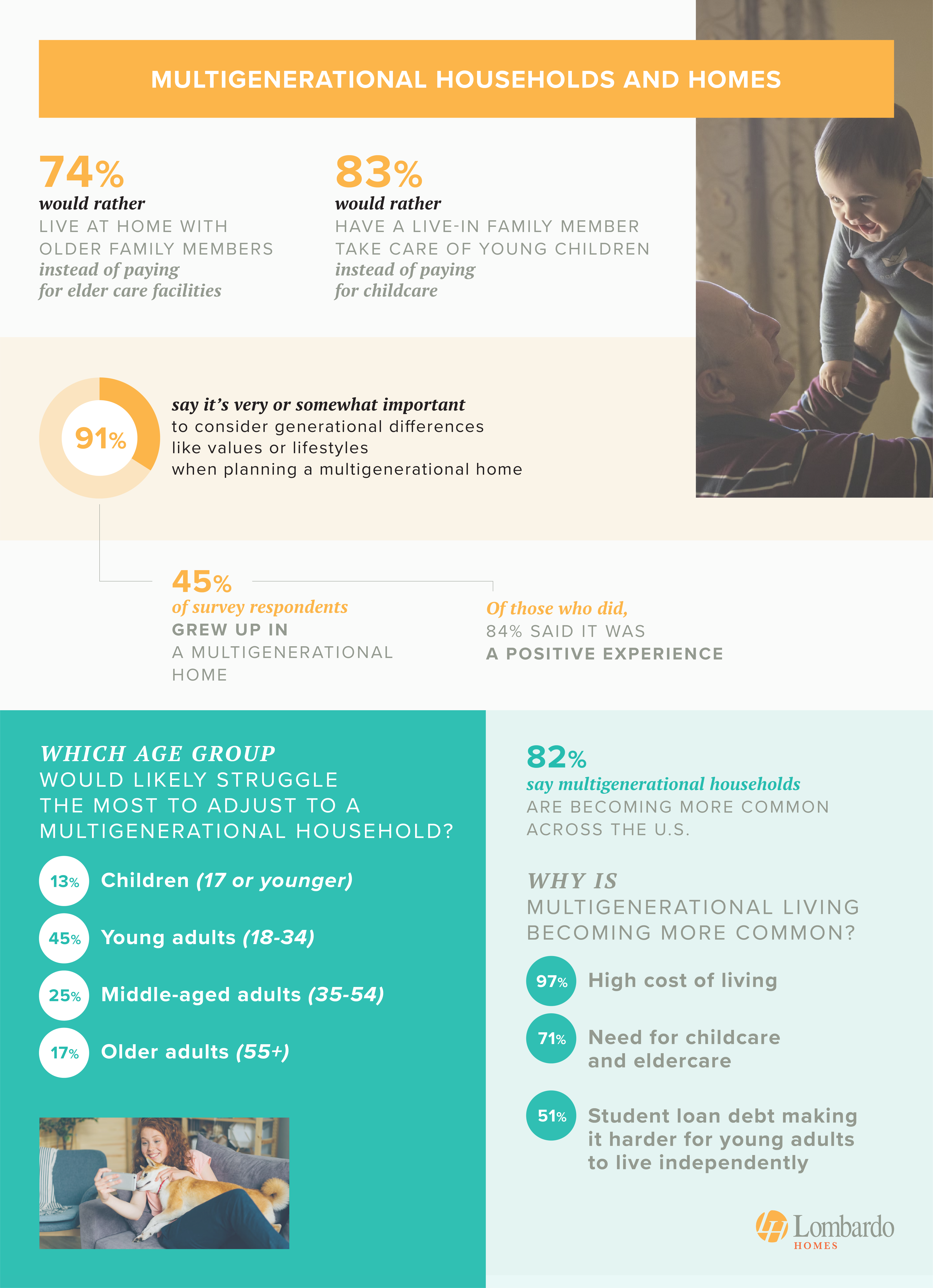
According to Pew Research Center data, more than 59 million Americans currently live in multigenerational homes. It could be because a twenty-something moved back home to save money, or maybe an aging family member needs additional care. Whatever the reason, more homes in America are seeing multi-generations all under one roof.
We surveyed 1,000 Americans to better understand the dynamics of multigenerational living and the levels of interest Americans have in living in a multigenerational home in the future.

Of the Americans surveyed, more than half (55%) currently live in a multigenerational household. The majority (61%) of those in Gen X (ages 44-59) primarily live in a multigenerational home. Gen X is followed by Gen Z (18-27) at 59%, Millennials (28-43) at 56%, and then Baby Boomers (60 – 78) at 33%.

Of the Americans who live in a multigenerational home, 95% say their households function successfully. The top reasons for living in a multigenerational home include finances (65%), maintaining close family ties (39%), help with shared responsibilities (28%), a need for eldercare (23%), and a desire for companionship (22%).
While financial reasons are the main motivator for multigenerational living, 82% say this living arrangement has improved the finances of at least one household member! For 63%, multigenerational living has also allowed at least one family to continue their education.
Having multiple family members spanning different ages can pose some challenges, including a lack of privacy for 62% of respondents. Balancing the different needs and lifestyles among generations can also be a challenge (46%), and it can be difficult to establish clear boundaries and expectations (34%).
One potential barrier to multigenerational living may be the home itself. A home needs to have enough space to address the needs of several adults in one home. Only 3 in 10 say their homes have separate living areas for different generations. One in 4 say they currently rent their homes, and of those who rent, 50% plan to buy a home in the next 5 years. Of the 75% who own their homes, they’ve owned the home for an average of 15 years.

Of Americans who don’t currently live in a multigenerational home, 31% say they’re considering the move. The generations considering the lifestyle change the most include Gen X (33%) and Millennials (33%), followed by Gen Z (28%) and Baby Boomers (25%).
Why consider this type of living? For 3 in 4 Americans, the reason is financial. More than half (53%) also say a need for eldercare is another top reason, followed by a desire for stronger family bonds (37%).
Multigenerational living can mean living with parents, grandparents, grandchildren, adult children, or any combination of adult family members. Living with family members is one thing, but not everyone may be willing to live with different generations. Of respondents not currently living in a multigenerational home, 61% would be willing to live with their parents, 70% would be willing to live with their adult children, 58% would be willing to live with their grandchildren, and 38% would be willing to live with their grandparents. However, 62% would not want to live with their grandparents, and 39% would not want to live with their parents.

Despite challenges such as privacy and balancing different lifestyles, the benefits are evident, with improved finances as a top advantage. Almost half (45%) of respondents grew up in a multigenerational home, and of those who did, 84% said it was a positive experience.
Among Americans, about 3 in 4 would rather live at home with older family members instead of paying for elder care facilities. The majority (83%) would also choose to have a family member live in their homes to help take care of young children instead of paying for childcare.
Nearly all (91%) respondents say it’s important to consider generational differences, such as lifestyles and values when planning a multigenerational home. Different age groups may have difficulty adjusting to this lifestyle change, with 45% of respondents believing young adults (ages 18-34) and 25% saying middle-aged adults (35-54) as the groups who would struggle the most. While 13% of survey respondents believe younger children (17 or younger) and 17% think older adults (55 or older) may still struggle to adapt, it may not be as difficult.
Is generational living becoming more common in the U.S.? According to 82% of respondents, the answer is yes. This type of living is becoming more common due to the high cost of living (97%), a need for childcare or eldercare (71%), and the barrier of student loan debt impacting young adults (51%).
Driven by financial considerations, elder care needs, and the desire for stronger family connections, multigenerational living is more commonplace in the United States. As economic pressures continue to rise, multigenerational households are likely to become an even more practical solution for many American families.
In June 2024, we surveyed 1,001 Americans for feedback on living in multigenerational homes. Respondents were 48% female, 49% male, and 3% nonbinary with an age range of 18 to 80 and an average age of 39.
For media inquiries, contact [email protected]
Fair Use
When using this data and research, please attribute by linking to this study and citing Lombardohomes.com